1812: Bladensburg_a; Scenario 003.
Mylords,
I have the honor to submit my report on the engagement that has taken place at Bladensburg, Maryland, on the 24th of August, 1814.
I approached the township of Bladensburg, situated on the east side of the East Branch of the Potomac, on one o'clock p.m. on said day. The forces under my command consisted of the 4th, the 21st, the 44th, and the 85th Foot, elements of the Royal Marine Corps, and of the Royal Artillery. I found the bridge over East Branch not immediately defended, but enemy forces had positioned themselves within a short distance of the bridge on the far side, blocking the road to Washington. Two fords some distance north and south of the bridge seemed undefended, but the terrain on the far side was covered with woods, where enemy forces might be hidden. I estimated the enemy's strength at two regiments and some cavalry as well as artillery, but rumour reported that more forces were between this place and Washington.
The 85th Foot was immediately ordered to take the bridge with a surprise attack and secure a bridgehead on the far side of the creek. The 44th was despatched to the northern ford in order to secure a crossing, if practicable. The Congreve Rockets deployed near the bridge and took the enemy under fire, which however seemed not to have any serious effect. The rest of my forces remained in reserve.
Col. Thorton led three companies of the 85th over the bridge in person and secured a foothold on the far side. At least six strong enemy companies (I estimated them to be at least 70 men strong, each) closed in on them, however, and delivered a devastating fire at point-blank range. The 6th company, which had led the attack, took over 40 per Cent casualties. Col. Thorton decided to withdraw to our side of the bridge and deployed half of his regiment in extended line, while the other was held in reserve in order to exploit any weakness shown by the enemy. Thereupon the enemy likewise withdrew from the bridge, but remained within supporting distance.
Meanwhile Col. Mullins had led 6 companies of the East Essex across the northern ford, which was only lightly defended, while the 7th, 8th, and 9th company of said regiment deployed on our side and took the defenders under fire. At half past one, the regiment had secured a crossing and had deployed in the dense woods on the far side. The 2nd, 4th, and 5th company wheeled south and engaged the weak enemy forces defending a small stream running into the creek just south of the ford. They were pushed back easily. The rest of the regiment advanced in westward direction, along a marsh extending into the wood, which on its far side was defended by some militia which Col. Mullins estimated at 8 companies or about 600 men.
While all this occurred, the 85th was still holding our side of the bridge, while taking some casualties from enemy cannon and smallarm fire. The Congreve Rockets engaged the enemy cannon and disabled two of them.
At this moment I decided to send forward the 4th Regiment, the King's Own, which had been held in reserve until then. I ordered Col. Brooke to advance through the bridgehead secured by the 44th and to envelope the enemy's left under cover of the woods. Col. Mullins of the East Essex concentrated his regiment and wheeled south; Col. Brooke was ordered to fall in on his right and advance further.
Shortly after half past one, Col. Thorton of the 85th observed that the enemy shifted several companies to his left in order to meet the new threat from the 4th and 44h. Since the enemy battery had also been weakened, he decided it was time for another attempt at taking the bridge. (See map #1).
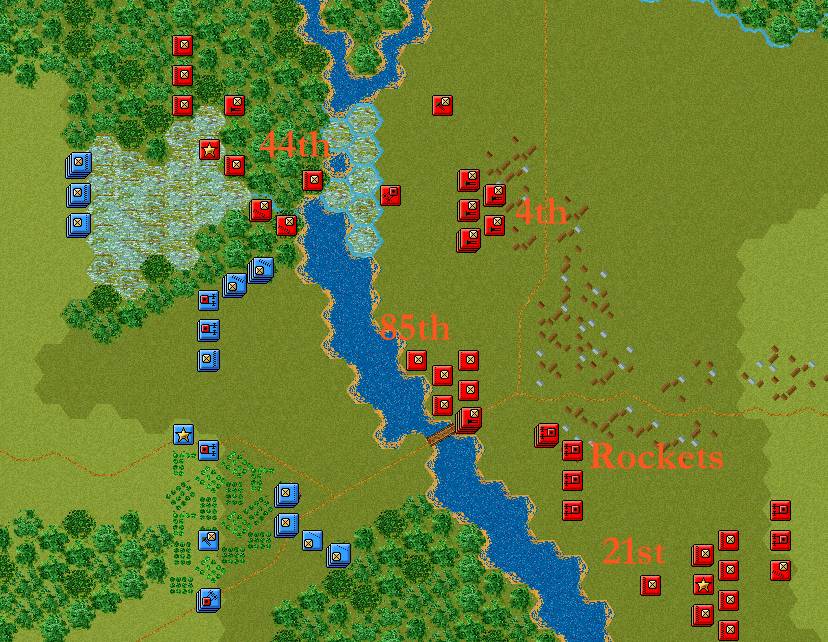
However, the enemy was still strong enough to check this second advance also. Three companies tried to establish a bridgehead on the far side, but again six enemy companies advanced to point-blank range, and although the three companies that had crossed managed to deploy into line with remarkable steadfastness, they took heavy casualties and finally two of them routed. The 8th Company, however, the courage of which deserves our attention, held and covered the retreat of the battalion.
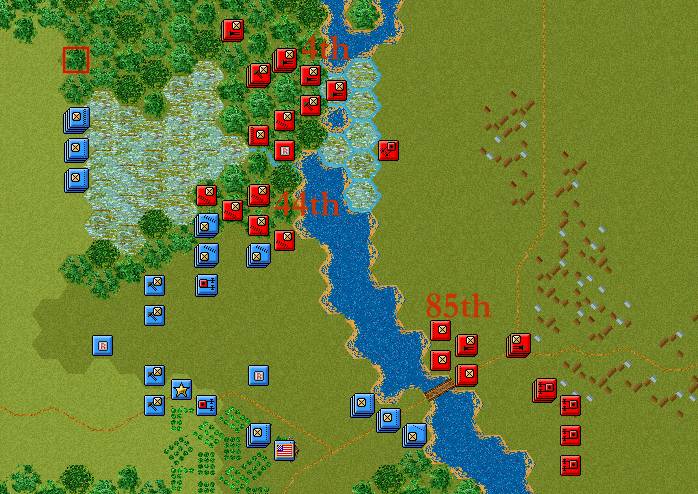
Meanwhile the 44th had made some headway against the enemy infantry at the southern edge of the forest near the northern ford. Some enemy companies were disordered, and it seemed as if they could not stand the steady fired delivered by our regulars (see map #2.) At about a quarter to two, however, I observed that the enemy was concentrating more and more troops against the East Essex. Col. Mullins decided to fall back into the cover of the woods and shorten the line, whereupon the enemy followed with about 10 companies, while some eight more closed in across the swamp. Shortly before two o'clock, the 2nd, 4th, and 6th company of the 44th could no longer withstand the pressure and fled to the rear. At this moment however, the King's Own Regiment had finally reached a position where they could fall onto the flank of the enemy militia companies in the swamp. Also five companies of the 85th and some Congreve rockets had deployed nearer to the enemy's line, on our side of the creek, and took the enemy flank under fire from thence.
At two o'clock I ordered a general advance. All reserves were to force the southern ford, where only a small company of dragoons seemed to be posted. The King's Own regiment emerged from the forest and took the enemy militia in the swamp from the rear; after two volleys, they fled in panic. (See map #3.)
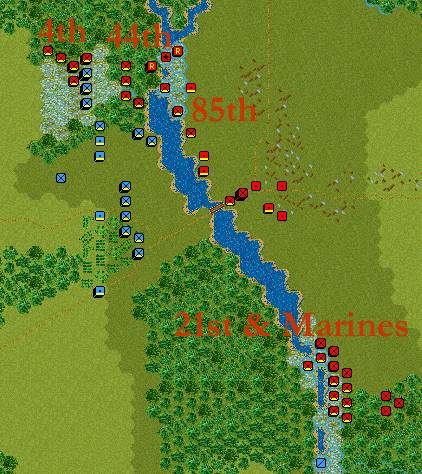
At half past two, the situation had completely changed and was developing in our favor. The King's Own had driven back the routed militia companies from the swamp southwards, and had done much execution in their ranks. Some fresh companies from the 44th and the 85th were joining the attack again. Together with them, the 4th formed a line of battle running from the southwestern edge of the swamp in southeastern direction towards the river. The enemy likewise formed into line of battle, opposing our line, but their defense was disorganized.
Meanwhile the 21st Regiment and the Marines had driven the dragoons from the southern ford and had marched through the forest. The 21st reached open ground south of the forest, deployed into a line of battle facing southwest, and advanced. The Royal Marines marched in northeastern direction, in the hope of coming into the enemy's flank or rear. (See map #4.)
At the same time the Congreve Rockets, which had been firing all day without achieving much results, ran out of ammunition.
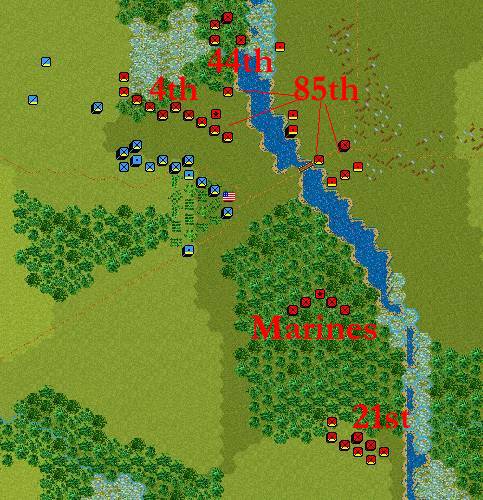
At three o'clock the battle reached its climax. The enemy was rushing reinforcements to the Bladensburg bridge. They approached on the road from Washington. However, the advance of my right wing had forced the enemy to fall back from the bridge. Now three more companies from the 85th crossed it and this time they reached the far side unopposed. The Royal Marines had advanced through the southern forest and emerged now from its northern edge, just in time to take an enemy column marching on the road in the flank. They opened fire, routed several companies, and took out some guns. Some skirmish in the woods ended favorably for us. The 21st had reached open ground south of the same forest and had deployed into line of battle. The regiment now advanced in western direction, three companies forming a refused flank. Some enemy companies in the open field west of the forest offered only a token resistance. Meanwhile the right wing continued to press the enemy back. Shortly after three o'clock, I had for the first time a continuous line of battle from the swamps in the north to the southwestern edge of the forest in the south. (See map #5.)
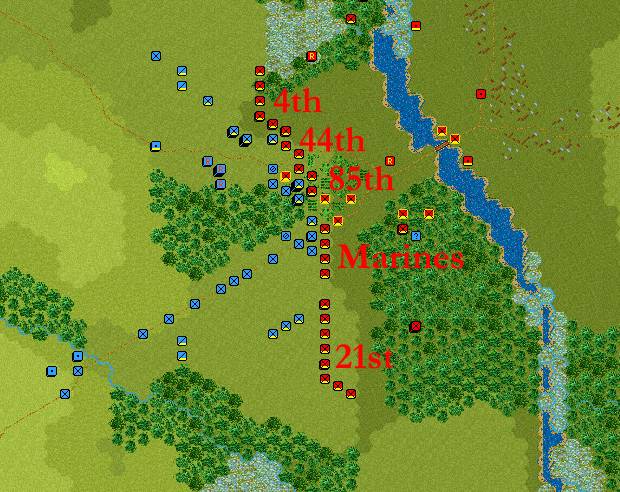
Though the enemy tried to make a stand with his newly arrived reinforcements, roughly along the Washington road, he could not withstand the hail of bullets now delivered by my line of battle. His left flank, which had been under continuous fire for more than two hours, collapsed first. The 4th regiment was ordered to pursue and eliminate what was left. The enemy's center broke next, some companies saw themselves isolated and surrendered. Only the right wing offered further resistance, and while the 21st encountered no particular difficulties in driving the militia companies of that wing back, they still had to do some real fighting. (See map #6.)
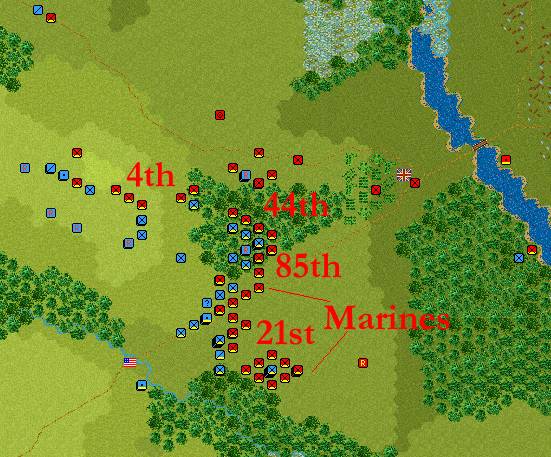
Around half past three, the enemy's line began to disintegrate. Several cannon were taken, and some companies laid down the arms. At a quarter to three, the commander of the American forces surrendered his shattered forces and the road to Washington was open.
The troops under my command deserve the highest praise for the steadfastness with which they fought this battle against the odds. As for their commander, the abortive advance across the bridge was certainly a tactical mistake. In the end, however, it nailed the enemy forces to the far side of the bridge and thus made the flanking movements possible that destroyed them.
The enemy lost heavily, 1,800 infantry and about 70 cavalry. We also took 13 guns. My own forces also suffered near 1,400 casualties, and one gun was disabled. Unfortunately, Col. Brooks of the 4th Regiment was killed, and Maj. Lewis of the Royal Marines was seriously wounded. On the other hand, we captured four enemy field officers during the engagement.
I have to remark that even a small detachment of cavalry would have been of great help.
I have the honor to remain, Mylords,
Your most obedient servant,
Maj. Gen. Ross
[aka Reg. Walter, 4th Regiment (King's Own), 1st Brigade, British Army (1812)]